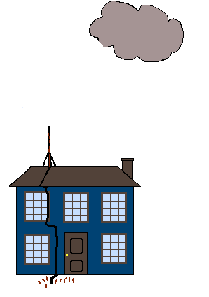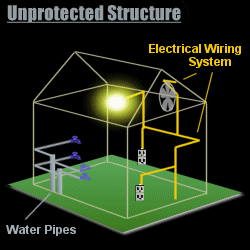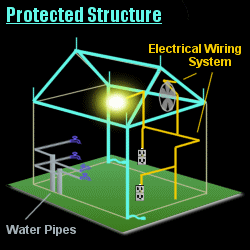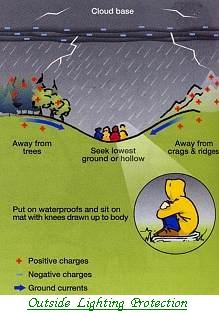

|
|

|

|
|
|
WEATHER LESSONS - Storm, Lightning Safety
|
|
|
Whole-Home protection systems
|
|
|
Founding father and inventor Ben Franklin can be credited for the beginnings of modern Lightning Protection Systems. Franklin observed that lightning tends to strike elevated objects, and that a network of conductors and grounding electrodes can carry lightning currents safely away from structures and into the earth to dissipate. Over 200 years later, such systems still do the job, and are all the more vital since contemporary structures contain far more conductive material than those built in Ben's day. 

The three main Lightning Protection Systems components are air terminals, conductors, and ground electrodes. Air terminals, also known as lightning rods, are placed at intervals on a home's roof and any high points projecting from it, and are designed so that lightning strikes them instead of the building. Conductors are the cables that run from among the air terminals to the ground electrodes, where lightning's charge is sent safely into the earth. For thorough lightning protection, you'll also need a complete network of connections which could include vent fans, gutters, water pipes, home electrical systems, phone lines and other vital connections. Between this and the tricky rooftop Lightning Protection Systems installation requirements, it's best to get the help of an experienced installer to set up your system. Pros are also needed to install surge arrestors, which protect your wiring and electrical equipment should a lightning-induced power surge travel down a power line toward your home. Surge arrestors are installed either outside where the electric service enters a building or at the inside service entrance, supplying a ground so that a power surge can't enter the structure. 
Lightning can strike anywhere and do millions of money worth of damage. Lightning is to blame for more deaths and property loss than tornadoes, hurricanes, and floods combined. And although we cannot yet predict where lightning will strike, there are some factors that increase the risk of a lightning strike. If your home or business meets 5 or more of the following criteria, you are in a high risk group.
As homes and businesses use more sensitive electronic equipment, it might be a smart idea if every building has a lightning protection system. This would prevent millions of money spent in replacing or repairing damaged equipment.
Lightning Protection Systems - What they do and don't do
A lightning protection system's only purpose is to ensure safety to a building and its occupants if lightning happens to hit it directly, a task accomplished by providing a good, safe path to ground for the lightning to follow. Contrary to the myths, lightning protection systems:
Lightning Protection Facts
|
|
How the Lighting Protection System works
|
||
|
||
|
||
|
||
|
||
|
Note: If the residence had not been equipped with a lightning protection system, the positive ground charge would have accumulated under or within the house. The negative cloud charge would not have been neutralized 150 feet above the residence and would have entered the building, causing possible fire, destruction, side flashes within the building or even injury or death. |
||
|
Top of page
|
||
|
Personal Lightning Safety
|
|
When storm approaches safety
If you are outside and you notice a storm brewing, do you know what to do? Here are a few safety tips: 
Indoor safety during a storm
Once you've got a lightning protection system in place, you may think you're safely indoors ahead of the storm. Well, you're not. Lightning can still impact home systems and your use of them, so the following precautions should be taken:
|
|
Top of page
|
|
General Lightning Safety Rules
|
||||||||||||||||||||||||||||||||||||||||||||||||||||||
|
||||||||||||||||||||||||||||||||||||||||||||||||||||||
|
Top of page
|
||||||||||||||||||||||||||||||||||||||||||||||||||||||
|
Top-10 Myths of Lightning Safety
|
||||||||||||||||||||||||||||||||||||||||||||||||||
|
||||||||||||||||||||||||||||||||||||||||||||||||||
|
Top of page
|
||||||||||||||||||||||||||||||||||||||||||||||||||
|
Recommended screen resolution: 1024x768, color quality: 32 bit and IE 5.x or higher Never base important decisions on this weather information Not to be used for protection of life and property!! KIFISSIA meteo Copyright © 2006 - Ioannis P. Fragos , All rights reserved
|